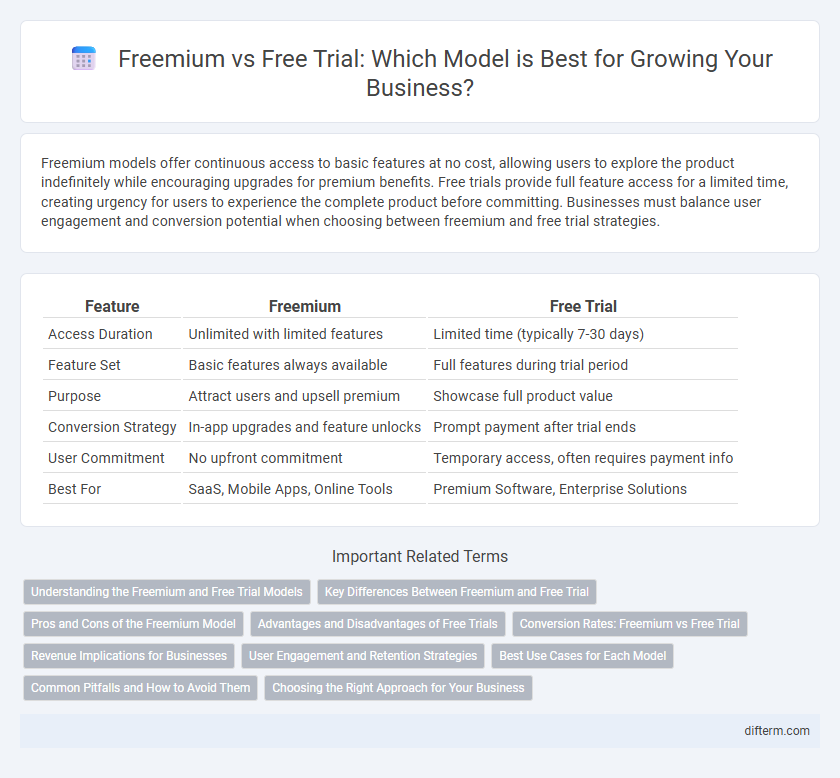Freemium models offer continuous access to basic features at no cost, allowing users to explore the product indefinitely while encouraging upgrades for premium benefits. Free trials provide full feature access for a limited time, creating urgency for users to experience the complete product before committing. Businesses must balance user engagement and conversion potential when choosing between freemium and free trial strategies.
Table of Comparison
| Feature | Freemium | Free Trial |
|---|---|---|
| Access Duration | Unlimited with limited features | Limited time (typically 7-30 days) |
| Feature Set | Basic features always available | Full features during trial period |
| Purpose | Attract users and upsell premium | Showcase full product value |
| Conversion Strategy | In-app upgrades and feature unlocks | Prompt payment after trial ends |
| User Commitment | No upfront commitment | Temporary access, often requires payment info |
| Best For | SaaS, Mobile Apps, Online Tools | Premium Software, Enterprise Solutions |
Understanding the Freemium and Free Trial Models
Freemium and free trial models serve distinct roles in customer acquisition and retention strategies. Freemium offers continuous, limited access to core features at no cost, encouraging upgrades through value-added premium options, while free trials provide full feature access for a restricted time to demonstrate product potential before purchase. Businesses leverage freemium models to build a broad user base and convert a fraction into paying customers, whereas free trials aim to accelerate purchase decisions by showcasing complete functionality upfront.
Key Differences Between Freemium and Free Trial
Freemium models provide users with ongoing access to a basic version of a product or service at no cost, while monetizing through premium feature upgrades or subscriptions. Free trials offer users temporary access to the full product or service, allowing them to evaluate its value before committing to a purchase. The freemium approach is designed for long-term user engagement and gradual conversion, whereas free trials create a sense of urgency to experience the full functionality within a limited timeframe.
Pros and Cons of the Freemium Model
The freemium model offers businesses a scalable way to attract a large user base by providing essential features for free while monetizing premium features, which can enhance brand loyalty and increase long-term revenue. However, it can lead to a high number of inactive users who never convert to paying customers, straining resources and potentially lowering perceived product value. Balancing free access with compelling premium incentives is crucial for maximizing conversion rates and sustaining profitability.
Advantages and Disadvantages of Free Trials
Free trials allow potential customers to experience a product's full features without initial payment, increasing conversion rates by building trust and reducing purchase hesitation. However, they can attract non-serious users who exploit the free period without intent to buy, leading to higher support costs and potential revenue loss. Businesses must balance trial duration and feature access to optimize user engagement while minimizing abuse and ensuring sustainable growth.
Conversion Rates: Freemium vs Free Trial
Freemium models often yield lower conversion rates, typically around 2-5%, due to prolonged access without time constraints, which can reduce urgency to upgrade. Free trials, with limited-time access (usually 7-30 days), tend to drive higher conversion rates, averaging 10-25%, by creating a sense of scarcity that motivates users to commit. Analyzing conversion funnels shows that free trials convert more effectively when paired with targeted onboarding and feature highlights, maximizing the perceived value during the trial period.
Revenue Implications for Businesses
Freemium models generate continuous revenue by converting a portion of free users into paying customers through premium features, enhancing long-term customer lifetime value. Free trials offer a limited-time experience that encourages immediate sign-ups and quicker revenue realization but risk higher churn if users do not see sustained value. Choosing between freemium and free trial impacts cash flow predictability and customer acquisition costs, influencing overall business profitability and growth strategies.
User Engagement and Retention Strategies
Freemium models attract a wide user base by offering core features at no cost, encouraging ongoing engagement through gradual feature upgrades that enhance user retention. Free trials provide limited-time access to premium features, creating urgency that boosts initial user activity but requires strategic follow-up to convert users into paying customers. Optimizing these strategies involves analyzing user behavior data to tailor feature offerings and communication, maximizing lifetime value and reducing churn rates.
Best Use Cases for Each Model
Freemium models excel in user acquisition by offering core features indefinitely, making them ideal for software products aiming to build a large user base and encourage upgrades through premium features. Free trials work best for high-value or complex services, allowing potential customers to experience the full product risk-free for a limited time, thereby driving conversion through demonstrated value. Businesses should choose freemium for scalable, ongoing engagement and free trials for immediate, high-impact product exposure.
Common Pitfalls and How to Avoid Them
Freemium models often struggle with low conversion rates due to offering too many free features, which reduces users' incentive to upgrade. Free trials can lead to high churn if users are not effectively engaged or educated during the trial period, causing missed opportunities for retention. Businesses should set clear upgrade triggers in freemium plans and implement proactive onboarding strategies during free trials to maximize paid conversion.
Choosing the Right Approach for Your Business
Selecting between freemium and free trial models depends on your business goals, target audience, and product complexity. Freemium models attract a broad user base with limited features, driving long-term engagement and upsell opportunities, while free trials offer full feature access for a short period, accelerating purchase decisions and demonstrating value quickly. Analyzing user behavior, conversion rates, and revenue impact helps determine which approach best aligns with your market strategy and growth objectives.
Freemium vs Free Trial Infographic

 difterm.com
difterm.com